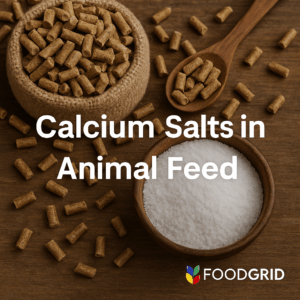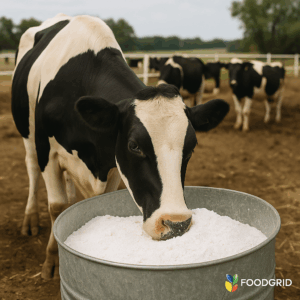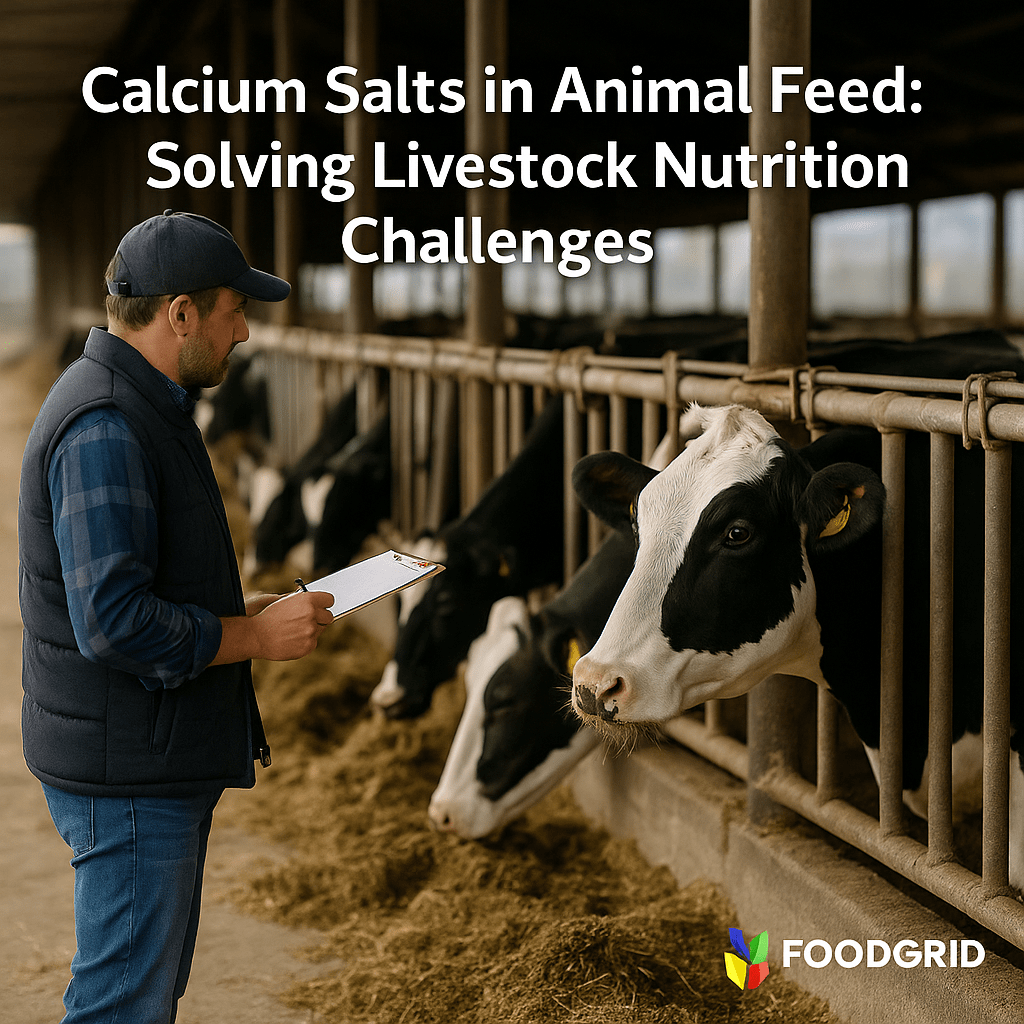Every livestock or aquaculture operation faces a common question: how to keep animals healthy, productive, and resilient in an increasingly competitive industry? Feed formulations play a central role in answering this. Among the many additives available, calcium salts have emerged as reliable problem-solvers that go far beyond bone health.
From fragile eggshells in poultry, to metabolic disorders in dairy cows, to gut infections in swine, calcium salts offer practical and science-backed solutions. This blog explores the key challenges in animal production and how calcium salts help overcome them.
The Dairy Challenge: Milk Fever and Energy Deficit
The Problem
High-yielding dairy cows, especially during transition and early lactation, face an energy deficit and a high risk of hypocalcemia (milk fever). Left unmanaged, this leads to:
- Reduced milk yield.
- Fertility problems.
- Increased veterinary costs.
The Calcium Salt Solution
- Calcium salts of fatty acids provide concentrated, rumen-protected energy to support peak milk production.
- Calcium carbonate balances rumen pH and maintains skeletal strength.
Result: Improved energy efficiency, higher milk yield, and lower incidence of metabolic diseases.
The Poultry Challenge: Eggshell Weakness and Skeletal Stress
The Problem
Poultry producers often struggle with thin or broken eggshells and leg weakness in broilers. Poor calcium nutrition results in losses through broken eggs, reduced hatchability, and skeletal disorders.
The Calcium Salt Solution
- Calcium carbonate with mixed particle sizes ensures both immediate and sustained calcium release for strong eggshells.
- Calcium lactate provides highly bioavailable calcium for young chicks, supporting bone development.
Result: Reduced egg breakage, better shell quality, improved broiler bone strength, and higher overall profitability.

The Swine Challenge: Gut Health and Antibiotic Reduction
The Problem
In pig production, gut health challenges (diarrhea, bacterial infections) cause growth setbacks. With global pressure to reduce antibiotic use, producers must find alternatives.
The Calcium Salt Solution
- Calcium formate acts as both a calcium source and a gut acidifier. It lowers intestinal pH, reducing harmful bacteria like E. coli and Salmonella.
- Improved gut health means better nutrient absorption and higher feed conversion ratios.
Result: Stronger piglets, reduced mortality, better weight gain, and less reliance on antibiotics.
The Aquaculture Challenge: Exoskeleton Formation and Nutrient Leaching
The Problem
In aquaculture, particularly shrimp and shellfish farming, challenges include:
- Weak exoskeletons leading to higher mortality.
- Nutrient leaching from feed into water, reducing efficiency.
The Calcium Salt Solution
- Calcium carbonate supports strong exoskeleton formation.
- Water-stable calcium formulations reduce leaching, ensuring nutrients reach the animal rather than polluting the environment.
- Calcium salts of fatty acids provide concentrated energy for fast-growing species under intensive farming.
Result: Healthier shrimp/fish, improved survival rates, and lower environmental impact.
Broader Benefits of Calcium Salts in Animal Nutrition
- Performance Optimization: Better growth rates, feed efficiency, and reproductive outcomes.
- Animal Welfare: Prevention of skeletal diseases, reduced stress, and healthier livestock.
- Economic Gains: Fewer veterinary interventions, higher product yield (milk, eggs, meat), and better ROI.
- Sustainability: Efficient mineral use reduces waste output, aligning with global environmental targets.
Practical Considerations for Producers
Product Selection
- Dairy: Calcium salts of fatty acids + calcium carbonate.
- Poultry: Calcium carbonate (coarse and fine) + calcium lactate.
- Swine: Calcium formate.
- Aquaculture: Calcium carbonate + stable formulations.
Quality and Consistency
Not all calcium salts are equal—variability in raw materials affects bioavailability. Partnering with reliable suppliers ensures consistent results.
Integration Into Diets
Balanced Ca:P ratios are critical. Oversupply of calcium can interfere with phosphorus and zinc absorption, leading to deficiencies.

Industry Outlook
- Global Feed Additives Market Growth: Expanding at 5–6% CAGR through 2033.
- Shift Toward Antibiotic-Free Production: Calcium formate positioned as a leading gut health tool.
- Aquaculture Expansion: Rising demand for calcium supplements in Asia-Pacific.
- Technological Integration: Precision nutrition tools now calculate optimal calcium salt inclusion rates.
Internal Resources for Further Exploration
- FoodGrid: Animal Feed Solutions → https://foodgridinc.com/
- FoodGrid Blog Library → https://foodgridinc.com/foodblog/
References
- Food and Agriculture Organization (FAO): https://www.fao.org/animal-production/en/
- National Institutes of Health (NIH): https://ods.od.nih.gov/factsheets/Calcium-Consumer/
- Alltech (Mineral Nutrition): https://www.alltech.com/animal-nutrition/dairy-cow
- ScienceDirect (Calcium feed research): https://www.sciencedirect.com/
- USDA Economic Research Service: https://www.ers.usda.gov/
From preventing milk fever in dairy cows, to improving eggshell quality in poultry, to enhancing gut health in swine, to strengthening exoskeletons in aquaculture, calcium salts have proven their value as reliable feed additives. They solve real challenges in animal production—driving both productivity and profitability.
👉 Explore FoodGrid’s calcium solutions here: https://foodgridinc.com/ and connect with us to design feed strategies that address your livestock or aquaculture challenges directly.
